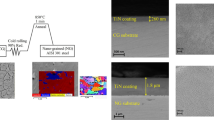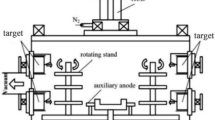Abstract
Three distinct layers are present in commercially produced tinplated steels: the top tin layer, the middle Fe-Sn alloy layer, and the bottom steel substrate. The brightness of these steels is inversely proportional to the roughness of the top layer. Substrate steels with recrystallized structure, sharper texture, and cleaner matrix result in flatter Fe-Sn interlayer and subsequently smoother top Sn layer. This in turn gives brighter surface finish.










Similar content being viewed by others
References
Morita J, Ezure K, Yoshida M and Ohga T, Nippon Steel Technical Report, 1994, 63 40-47
Catalá R, Cabañares JM, and Bastidas JM, Corrosion Science, 1998, 40, 1455 -1467
Gines Marcelo J L, Benitez GJ, Egli W, Zubimendi JL and Perez T, Plating and Surface Finishing, 2003, October, 2-7
Ramamurthy S, Walzak TL, Lu SF, Lipson TC and McIntyre NS, 1991, 17, 834-841
Bigerelle M, Marteau J, Paulin C, Surface Topography: Metrology and Properties, 2015, 3, 1-13
Darrort V, Troyon M, Ebotht J, Bissieux C, Nicollin C, Thin Solid Films, 1995, 265, 52-57.
Well R and Paquin RA, J. Electrochem. Soc., 1960, 107, 87-91
Aoki K, Noro K, Azushima A,” Tetsu-to-Hagane, 2008, 94, 438-444
P. Ghosh, Project report: Inconsistency in the Brightness of Tinplated Steels: Root Cause Analysis and Possible Remedies, 2017, Tata Steel, India
J.J.M. Granzier, R. Vergne, and K.R. Gegenfurtner: J. Vis., 2014, vol. 14, pp. 41–20.
P. Saikia, A. Joseph, R. Rane, B.K. Saikia, and S. Mukherjee: J. Theor. Appl. Phys., 2013, vol. 7, art. no. 66.
S. Wienströer, M. Fransen, H. Mittelstädt, C. Nazikkol, M. Völker: Adv. X-ray Anal., 2003, vol. 46, p. 291.
Chakraborty A, Ray RK, Surface and Coatings Technology, 2009, 203, 1756-1764
Y. Deng, H. Di, J. Zhang, and R.D.K. Misra: Metall. Res. Technol., 2017, vol. 114, art. no. 502.
N. Niehaus, W. Friehe, W. Schwenk, US Patent 4,513,995, 1985.
E.E. Vonada: US Patent 2,673,836, 1954.
J.S. Nachtman: US Patent 2,240,265, 1941.
Clarke M, Bernie JA, Electrochimica Acta, 1967, 12, 205-212
T.F. Davis: US Patent 4,194,913, 1980.
J. Heber, A. Egli, M. Toben, and F. Schwager: US Patent App. 10/098,983, 2002.
Van Houtte P, The MTM-FHM Software System, Version 2, Department of Metallurgy and Materials Engineering, Katholieke Universiteit Leuven, Belgium
Bunge HJ, “Zeitschrift Fur Metallkunde, 1965, 56, 872-874
Van Houtte P, Texture and Microstructures, 1987, 7, 29-72
Van Houtte P, Texture and Microstructures, 1987, 7, 187-205
Van Houtte P, ICOTOM, 1984, 7, 7-23
Daniel D and Jonas JJ, Metallurgical Transaction, 1990, 21A, 331-343
Ray RK, Jonas JJ and. Hook EE, Int. Materials review, 1994, 39, 129–172
Biber HE and Harter WT, Journal of the Electrochemical Society, 1966, 113, 828-834
Hokkeling P, Damsma H and Havinga EE, Journal of the Less-Common Metals, 1972, 27, 169-186
S. Suwas and R. K. Ray, Crystallographic Texture of Materials, Engineering Materials and Processes, Springer-Verlag London 2014
Cheong S and Weiland H, Materials Science Forum, 2007, 558-559, 153-158
Ayad A, Bonasso NA, Rouag N and Wagner F; Materials Science Forum, 2011, 702-703, 269-272.
Dutta B and Sellars CM, Mater. Sci. Technol.,1987, 3, 197-206
Ghosh C, Aranas C Jr. and Jonas JJ, Progress in Materials Science, 2016, 82, 151-233
Ghosh C, Basabe VV, Jonas JJ, Kim YM, Jung IH and Yue S, Acta Mater., 2013, 61, 2348-2362
Maa X, Mia C, Langeliera B and Subramanian S, Materials & Design, 2017, 132, 244-249
Mills AR, Thewlis G and Whiteman JA, Mater. Sci. Technol., 1987, 3, 1051–1061
Thewlis G, Mater. Sci. Technol., 1994, 10, 110
Grong O, Kluken AO, Hylund HK, Dons AL and Hjelen H, Metall. Mater. Trans. A, 1995, 26A, 525.
Yamada T, Terasaki H and Komizo YI, ISIJ International, 2009, 49, 1059–1062
Acknowledgments
The authors would like to thank the management of Tata Steel, India for giving us the permission to publish this paper. The principal author would also like to thank Mr. Soumya Chatterjee for the many fruitful discussions they had from time to time. This research did not receive any specific grant from funding agencies in the public, commercial, or not-for-profit sectors.
Data Availability statement
The raw/processed data required to reproduce these findings cannot be shared at this time due to technical or time limitations.
Author information
Authors and Affiliations
Corresponding author
Additional information
Publisher's Note
Springer Nature remains neutral with regard to jurisdictional claims in published maps and institutional affiliations.
Manuscript submitted July 26, 2018.
Appendix A
Appendix A
Time of reaction: 16 seconds
1 lb/bb = 22.4 g/m2
Atomic weight of Sn: 118.7
Atomic weight of Fe: 55.8
Density of FeSn2: 8.55 g/cc
-
1.
Calculation of Sn in the form of FeSn2 formed on steel substrate after 16 seconds[28]:
-
On (100) surface = 0.25 lb/bb = 2.8 g/m2
-
On (110) surface = 0.13 lb/bb = 1.456 g/m2
-
On (111) surface = 0.17 lb/bb = 1.904 g/m2
-
-
2.
Calculation of FeSn2 formed on steel substrate after 16 seconds:
In FeSn2, 2Sn atoms attached with one Fe atom.
Therefore, (2 × 118.7) g of Sn is present in (2 × 118.7 + 55.8) g FeSn2
Therefore, after 16 seconds
-
(100) oriented grains of the samples would have 3.458 g/m2 or 3.458 × 10−4g/cm2 of FeSn2
-
(110) oriented grains of the samples would have 1.798 g/m2 or 1.798 × 10−4g/ cm2 of FeSn2
-
(111) oriented grains of the samples would have 2.351 g/m2 or 2.351 × 10−4g/ cm2 of FeSn2
-
3.
Calculation of FeSn2 layer height on (100), (110), and (111) oriented grains
Assuming in the present case, the height of FeSn2 layer on (100), (110), and (111) are h100, h110, and h111, respectively.
For (100) oriented grains for every 1 cm2 area:
The volume of FeSn2 would be h100 *1 cm2 = h100 cm2. The weight of this FeSn2 as calculated is 3.458 × 10−4 g.
Now, the density of FeSn2 is 8.55 g/cm329.
Therefore, 3.458 × 10−4 g of FeSn2 ≡ 0.404 × 10−4 cm3 of FeSn2.
Similarly, h110 and h111 are calculated as =0.210 µm and 0.275 µ, respectively.
Rights and permissions
About this article
Cite this article
Ghosh, P., Mondal, D., Tiwari, A. et al. Influence of Microstructure and Crystallographic Texture on the Surface Brightness of Industrially Produced Tinplated Steels. Metall Mater Trans A 50, 1825–1836 (2019). https://doi.org/10.1007/s11661-019-05129-9
Received:
Published:
Issue Date:
DOI: https://doi.org/10.1007/s11661-019-05129-9




